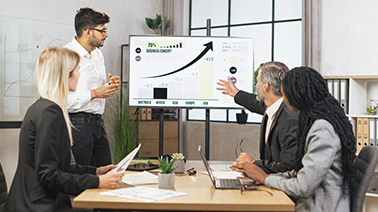In today's ever-evolving landscape of security and hospitality, the concept of visitor management has emerged as a crucial facet of organizational operations. This article embarks on a journey to explore the intricate interplay between technological innovation and human-centric design in the realm of visitor management. Gone are the days of antiquated sign-in logs and manual processes; instead, organizations worldwide are embracing sophisticated digital solutions to not only bolster security measures but also elevate the overall visitor experience.
This introductory paragraph sets the stage for a comprehensive examination of how modern visitor management systems are reshaping the way businesses and institutions interact with guests, seamlessly blending cutting-edge security protocols with personalized touches to create welcoming and secure environments.
Through a lens of innovation and adaptability, this article seeks to uncover the transformative potential of redefined visitor management practices, highlighting their pivotal role in fostering safety, efficiency, and positive impressions across diverse sectors and settings.
Traditional Visitor Management Systems
Traditional visitor management systems have long relied on manual processes and physical documentation to monitor and regulate the influx of guests into various facilities. These systems typically involve the use of sign-in sheets, visitor logs, and paper badges, where visitors are required to provide their name, contact information, and purpose of visit upon arrival. In some cases, security personnel may manually verify visitor credentials and issue temporary passes or badges for identification purposes.
However, traditional visitor management systems suffer from several inherent limitations. Firstly, the reliance on paper-based records makes it challenging to maintain accurate and up-to-date information, increasing the risk of errors and inconsistencies. Moreover, the manual nature of these systems often results in inefficiencies and delays, particularly during peak visitor periods when queues can form at reception desks. Additionally, traditional methods offer limited security features, as they lack real-time monitoring capabilities and fail to integrate with advanced access control systems.
Furthermore, the reliance on physical documentation poses potential privacy concerns, as sensitive visitor information may be vulnerable to unauthorized access or mishandling. In cases where visitor logs are stored on-site, there is also the risk of loss or damage due to accidents or natural disasters.
Overall, while traditional visitor management systems have served their purpose in the past, their inherent limitations make them ill-suited for today's fast-paced and security-conscious environments. As organizations seek to enhance both security measures and visitor experiences, there is a growing need to transition towards more advanced and digitally-driven solutions.
Emergence of Digital Visitor Management Systems
The emergence of digital visitor management systems marks a significant shift in how organizations approach the task of managing and monitoring visitor traffic. Unlike their traditional counterparts, digital systems leverage cutting-edge technology to streamline processes, enhance security, and improve overall visitor experiences.
One of the key features of digital visitor management systems is their ability to automate the check-in process. With self-service kiosks and online pre-registration options, visitors can check in quickly and efficiently, reducing wait times and eliminating the need for manual paperwork. This not only improves the visitor experience by making the check-in process more convenient but also frees up staff resources to focus on other tasks.
Additionally, digital visitor management systems offer enhanced security features compared to traditional methods. By integrating with access control systems and incorporating features such as facial recognition and ID scanning, these systems can verify the identity of visitors more accurately and prevent unauthorized access to secure areas. Real-time monitoring capabilities also allow security personnel to track visitor movement throughout the premises and respond swiftly to any security incidents or emergencies.
Furthermore, digital visitor management systems provide organizations with valuable data and insights that can be used to improve operations and customer service. By capturing visitor demographics, entry and exit times, and popular visitation areas, organizations can better understand visitor behavior and preferences. This data can inform decision-making processes and help organizations optimize resource allocation, facility layouts, and staffing levels to better meet visitor needs.
Key Features of Modern Visitor Management Systems
- Automated Check-in Processes: Modern visitor management systems streamline the check-in process through automation, utilizing self-service kiosks and online pre-registration options. This reduces wait times, enhances efficiency, and eliminates the need for manual paperwork.
- Visitor Tracking and Monitoring: These systems offer real-time monitoring capabilities, allowing organizations to track visitor movement throughout their premises. This enables better security management and facilitates quick response to any incidents or emergencies.
- Integration with Access Control Systems: Modern visitor management systems seamlessly integrate with access control systems, ensuring that only authorized individuals gain entry to secure areas. This enhances overall security measures and minimizes the risk of unauthorized access.
- Customization Options: These systems provide organizations with customization options to tailor the visitor experience according to their specific needs and preferences. This may include personalized greetings, notifications, and visitor badges, enhancing overall visitor satisfaction.
- Data Capture and Analysis: Visitor management systems capture valuable data such as visitor demographics, entry/exit times, and visitation patterns. This data can be analyzed to gain insights into visitor behavior and preferences, enabling organizations to make informed decisions to improve operations and customer service.
- Visitor Identification and Screening: Modern systems employ advanced identification and screening methods, including facial recognition and ID scanning, to accurately verify visitor identity and screen for any potential security threats. This enhances security measures and ensures a safe environment for both visitors and staff.
- Mobile Accessibility: Many modern visitor management systems offer mobile accessibility, allowing visitors to check in using their smartphones or tablets. This provides added convenience and flexibility, especially in environments where self-service kiosks may not be available.
- Emergency Response Capabilities: In the event of security incidents or emergencies, modern visitor management systems provide capabilities for swift emergency response, including automated alerts and notifications to security personnel. This helps mitigate risks and ensures a prompt and coordinated response to threats or emergencies.
How Does Visitor Management System Enhance Security?
- Identification and Verification: Visitor management systems enhance security by accurately identifying and verifying the identity of visitors. This may involve the use of biometric authentication, such as facial recognition or fingerprint scanning, to ensure that individuals are who they claim to be.
- Screening for Security Threats: These systems screen visitors against watchlists or databases of known security threats, such as individuals with criminal records or those on terrorist watchlists. By flagging potential threats, visitor management systems help prevent unauthorized access and enhance overall security measures.
- Access Control Integration: Modern visitor management systems seamlessly integrate with access control systems, ensuring that only authorized individuals gain entry to secure areas within a facility. This helps prevent unauthorized access and reduces the risk of security breaches.
- Real-time Monitoring: Visitor management systems provide real-time monitoring capabilities, allowing security personnel to track visitor movement throughout a facility. This enables quick detection of any suspicious behavior or unauthorized access attempts, facilitating a prompt response to security incidents.
- Alerts and Notifications: In the event of security breaches or emergencies, visitor management systems can automatically generate alerts and notifications to security personnel. This ensures that security teams are promptly informed of any potential threats or incidents, allowing them to take appropriate action to mitigate risks.
- Visitor Tracking: These systems track the movement of visitors within a facility, recording entry and exit times as well as their whereabouts during their visit. This information can be used to conduct post-incident investigations or to verify visitor compliance with security protocols.
- Emergency Response Capabilities: Visitor management systems are equipped with emergency response capabilities, enabling security personnel to quickly respond to security incidents or emergencies. This may include initiating lockdown procedures, evacuating visitors, or coordinating with law enforcement authorities as necessary.
How Does Visitor Management System Help in Improving Visitor Experiences?
- Streamlined Check-in Process: New visitor management systems streamline the check-in process, making it quicker and more efficient for visitors. Self-service kiosks and online pre-registration options reduce wait times, allowing visitors to check in seamlessly without the need for manual paperwork or lengthy queues.
- Personalized Greetings and Notifications: These systems offer the ability to personalize greetings and notifications for visitors based on their preferences or past interactions. This adds a personal touch to the visitor experience, making visitors feel welcome and valued upon arrival.
- Easy Access to Facilities and Amenities: Visitor management systems can provide visitors with information about facility amenities, such as restrooms, cafeterias, or meeting rooms. This helps visitors navigate the premises more easily and ensures that they have access to the resources they need during their visit.
- Visitor Badges and Identification: Modern visitor management systems issue visitor badges or IDs upon check-in, clearly identifying visitors and their purpose for being on-site. This enhances security measures while also making it easier for staff to identify and assist visitors as needed.
- Wayfinding Assistance: Some visitor management systems offer wayfinding assistance to help visitors navigate large or complex facilities. This may include digital maps or directions to specific locations within the premises, ensuring that visitors can easily find their way around.
- Enhanced Communication Channels: Visitor management systems enable organizations to communicate important information or updates to visitors in real-time. This may include notifications about events, safety protocols, or changes to operating hours, enhancing overall communication and transparency.
- Feedback Collection: New visitor management systems may include features for collecting visitor feedback about their experience. This allows organizations to gather valuable insights and make improvements to the visitor experience based on visitor input.
- Integration with Other Systems: These systems can integrate with other organizational systems, such as customer relationship management (CRM) or marketing automation platforms. This allows organizations to track visitor interactions across various touchpoints and tailor future interactions based on visitor preferences and behavior.
Final Words
Visitor management is undergoing a transformation, driven by technological advancements and evolving security needs. By embracing modern solutions, organizations can enhance security, streamline operations, and provide memorable experiences for their visitors. As the digital landscape continues to evolve, the role of visitor management will remain critical in safeguarding assets and fostering positive interactions.






